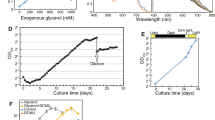Abstract
In light-dark-synchronized cultures of the unicellular green algaChlamydomonas reinhardtii, release of zoospores from the wall of the mother cell normally takes place during the second half of the dark period. The recently isolated mutant ‘ls’, however, needs light for the liberation of zoospores when grown photoautotrophically under a 12 h light-12 h dark regime. The light-induced release of zoospores was found to be prevented by addition of the photosystem-II inhibitor 3-(3′,4′-dichlorophenyl)-1,1-dimethylurea. Furthermore, light dependence of this process was shown to be abolished when the mutant ‘ls’ was grown either photoautotrophically under a 14 h light-10 h dark regime or in the presence of acetate. Our findings indicate that the light-dependency of zoospore liberation observed in cultures of this particular mutant during photoautotrophic growth under a 12 h light-12 h dark regime might be attributed to an altered energy metabolism. The light-induced release of zoospores was found to be prevented by addition of cycloheximide or chloramphenicol, antibiotics which inhibit protein biosynthesis by cytoplasmic and organellar ribosomes, respectively. Actinomycin D, an inhibitor of RNA synthesis, however, did not affect the light-induced liberation of zoospores.
Sporangia accumulate in stationary cultures of the mutant ‘ls’. Release of zoospores was observed when these sporangia were collected by centrifugation and incubated in the light after resuspension in fresh culture medium. Since liberation of zoospores was not observed after dilution of the stationary cultures with fresh culture medium, we suppose that components which interfere with the action of the sporangial autolysin are accumulated in the culture medium of the mutant ‘ls’.
Similar content being viewed by others
Abbreviations
- DCMU:
-
3-(3′,4′-dichlorophenyl)-1,1-dimethylurea
References
Bernstein, E. (1964) Physiology of an obligate photoautotroph (Chlamydomonas moewusii). I. Characteristics of synchronously and randomly reproducing cells and an hypothesis to explain their population curves. J. Protozool.11, 56–74
Bold, H.C. (1942) The cultivation of algae. Bot. Rev.8, 69–138
Bruce, V. (1970) The biological clock inChlamydomonas reinhardtii. J. Protozool.17, 334–340
Craigie, R.A., Cavalier-Smith, T. (1982) Cell volume and the control of theChlamydomonas cell cycle. J. Cell Sci.54, 173–191
Donnan, L., John, P.C.L. (1983) Cell cycle control by timer and sizer inChlamydomonas. Nature304, 630–633
Droop, M.R. (1974) Heterotrophy of carbon. In: Algal physiology and biochemistry, pp. 530–559, Stewart, W.D.P., ed. Blackwell, Oxford
Grant, D., Swinton, D.C., Chiang, K.-S. (1978) Differential patterns of mitochondrial, chloroplastic and nuclear DNA synthesis in the synchronous cell cycle ofChlamydomonas reinhardtii. Planta141, 259–267
Howell, S.H., Blascho, W.J., Drew, C.M. (1975) Inhibitor effects during the cell cycle inChlamydomonas reinhardtii: Determination of transition points in the asynchronous cultures. J. Cell Biol.67, 126–135
Howell, S.H., Posakony, J.W., Hill, K.R. (1977) The cell cycle program of polypeptide labeling inChlamydomonas reinhardtii. J. Cell Biol.72, 223–241
Jaenicke, L., Kuhne, W., Spessert, R., Wahle, U., Waffenschmidt, S. (1987) Cell-wall lytic enzymes (autolysins) ofChlamydomonas reinhardtii are (hydroxy)proline-specific proteases. Eur. J. Biochem.170, 485–491
Jarrett, R.M., Edmunds, L.N. (1970) Persisting circadian rhythm of cell division in a photosynthetic mutant ofEuglena. Science167, 1730–1733
John, P.C.L. (1984) Control of the cell division inChlamydomonas. Microbiol. Sci.1, 96–101
Lien, T., Knutsen, G. (1979) Synchronous growth ofChlamydomonas reinhardtii (Chlorophyceae): a review of optimal growth conditions. J. Phycol.15, 191–200
Lorenzen, H., Hesse, M. (1974) Synchronous cultures. In: Algal physiology and biochemistry, pp. 894–908, Stewart, W.D.P., ed. Blackwell, Oxford
Lowry, O.H., Rosebrough, N.J., Farr, A.L., Randle, R.J. (1951) Protein measurements with the folin phenol reagent. J. Biol. Chem.193, 257–265
McMahon, D. (1975) Cycloheximide is not a specific inhibitor of protein synthesis in vivo. Plant Physiol.55, 815–821
Mergenhagen, D. (1980) Die Kinetik der Zoosporenfreisetzung bei einem Mutantenstamm vonChlamydomonas reinhardtii. Mitt. Inst. Allg. Bot. Hamburg17, 18–26
Mittelsten-Scheid, O. (1985) Untersuchungen zur Zoosporen-freisetzung beiChlamydomonas reinhardtii Dangeard. Dissertation. University of Hamburg, FRG
Mihara, S., Hase, E. (1971) Studies on the vegetative life cycle ofChlamydomonas reinhardtii Dangeard in synchronous culture. I. Some characteristics of the cell cycle. Plant Cell Physiol.12, 225–236
Mihara, S., Hase, E. (1975) Studies on the vegetative life cycle ofChlamydomonas reinhardtii Dangeard in synchronous culture. III. Some notes on the process of zoospore liberation. Plant Cell Physiol.16, 371–375
Pirson, A., Lorenzen, H. (1966) Synchronized dividing algae. Annu. Rev. Plant Physiol.17, 439–458
Sager, R., Granick, S. (1953) Nutritional studies withChlamydomonas reinhardtii. Ann New York Acad. Sci.56, 831–838
Schlösser, U.G. (1966) Enzymatisch gesteuerte Freisetzung von Zoosporen beiChlamydomonas reinhardtii Dangeard in Synchronkultur. Arch. Mikrobiol.54, 129–159
Schlösser, U.G. (1976) Entwicklungsstadien- und sippenspezifische Zellwand-Autolysine bei der Freisetzung von Fortpflanzungszellen in der GattungChlamydomonas. Ber. Dtsch. Bot. Ges.89, 1–56
Spudich, J.L., Sager, R. (1980) Regulation of theChlamydomonas cell cycle by light and dark. J. Cell Biol.85, 136–145
Sueoka, N. (1960) Mitotic replication of deoxyribonucleic acid inChlamydomonas reinhardtii. Proc. Natl. Acad. Sci. USA46, 83–91
Surzycki, S. (1971) Synchronously grown cultures ofChlamydomonas reinhardtii. Methods Enzymol.23, 67–73
Tamiya, H. (1966) Synchronous cultures of algae. Annu. Rev. Plant Physiol.17, 1–26
Voigt, J., Münzner, P. (1987) TheChlamydomonas cell cycle is regulated by a light/dark-responsive cell-cycle switch. Planta172, 463–472
Voigt, J., Wieland, T., Sekeris, C.E. (1978) Initial steps in the induction by glucocorticosteroids of rat liver tryptophan oxygenase and tyrosine aminotransferase. Arch. Biochem. Biophys.191, 101–109
Author information
Authors and Affiliations
Rights and permissions
About this article
Cite this article
Voigt, J., Mergenhagen, D., Münzner, P. et al. Effects of light and acetate on the liberation of zoospores by a mutant strain ofChlamydomonas reinhardtii . Planta 178, 456–462 (1989). https://doi.org/10.1007/BF00963815
Received:
Accepted:
Issue Date:
DOI: https://doi.org/10.1007/BF00963815




